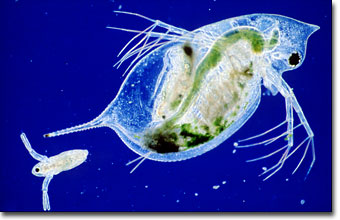Spike (M.I.) Walker
Water Flea (Daphnia)
English photomicrographer Spike (M.I.) Walker has been a consistent winner of the Nikon Small World competition for many years and has published many articles and a book about microscopy. Featured below is a photomicrograph of a water flea.

|
A Water flea (Daphnia) was photographed in fresh water. The specimen began to give birth before Spike could press the shutter release but, as luck would have it, the 'newborn' briefly returned to the field of view before swimming away. The photomicrograph was captured with Rheinberg illumination utilizing a blue central filter. The photomacrography equipment consisted of a Zeiss Tessovar zoom macro with a Bowen Illumitran transparency copier used as a flash light source in conjunction with a 2-inch aspheric condenser. (5x) |
Daphnia are microscopic crustaceans, belonging to the order Cladocera, that populate the quiet waters of lakes and ponds throughout the world. Most species are found in freshwater habitats, but a few occur in marine environments. Daphnia has a discrete head bearing antennae and a bivalve carapace that encloses all or most of the trunk and abdomen. While it is barely visible to the naked eye, under the microscope the daphnia's internal structures can be easily discerned, particularly the beating heart that lies along the back. Daphnia is one of many groups of cladocerans nicknamed "water fleas" because of their resemblance to the common flea and their characteristic "hopping" locomotion associated with the strongly beating antennae.
Like other cladocerans, daphnia are an important part of the food chain, filter-feeding on microscopic particles and phytoplankton and, in turn, providing food for juvenile fish. In the Great Lakes of North America, water fleas are the basic food for nearly all commercial fish species.
Cladocerans, such as daphnia, are parthenogenetic most of the year, producing unfertilized eggs that, in turn, produce females. Towards the end of seasonal population peaks, in a mechanism not well understood, parthenogenetic females produce parthenogenetic male eggs. Sexual females are also produced parthenogenetically. They copulate with the males, producing a small number of resistant eggs. These resistant eggs can overwinter, withstand drying and freezing, etc. and will hatch when conditions permit. These eggs aid in dispersal between bodies of water and allow species to endure in ephemeral habitats.
